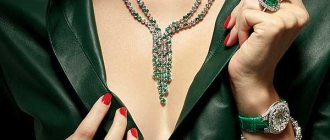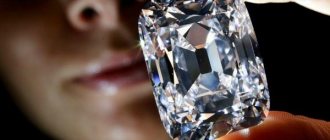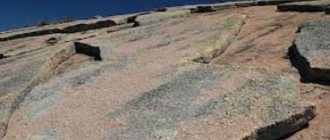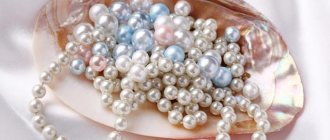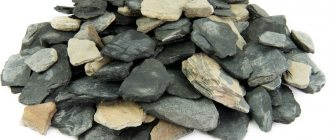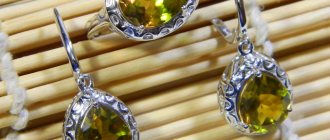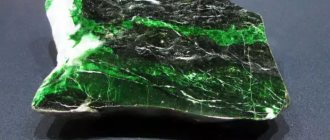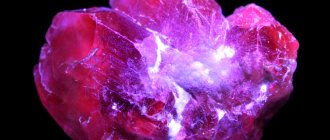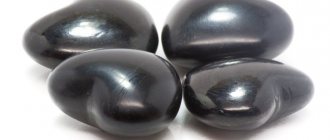There are many mysteries associated with this stone. It is considered semi-precious, but costs the same as a diamond and even more. The natural reserves of such gems are kept secret, so no one will say when they will run out. The color of the mineral cannot be described in one word because it changes depending on the lighting. The name of the “stranger” that all fashionistas in the world dream of is Sultanite.
Description and uniqueness of the stone
Sultanite (diaspora, thanatarite, zultanite) is a symbol of Turkey, a rare semi-precious stone. It has an unusual quality that only 1% of earth's minerals have. Like alexandrite, it can change color, but it has a richer and more varied palette of shades.
Under different lighting angles, the same stone shimmers with yellow, amber, crimson, brown, and rich green shades. Plus, it gives off lots of sparkling highlights. By purchasing a product with a diaspora, you can get the effect of several decorations that can be easily combined with different wardrobe items.
It is transparent, like sapphire or ruby, but very fragile. The chemical composition of sultanite includes two main components - corundum (75%) and water (25%), therefore mineralogists call it watery corundum.
Although corundum is known for its hardness, this gem is unusually fragile. Due to increased fragility, up to 97% of the original weight of nuggets is lost during processing and mining. The fragility of sultanite is explained by the fact that it contains hydrogen ions, which destroy the atoms of the crystal.
In addition to fragility, the mineral has the following physical characteristics:
- Hardness – 6.5/10 on the Moss scale.
- Density – 3.5 g/cm3.
- Pearlescent or glassy luster.
- Opaque or translucent.
- Color - from white, colorless, pale yellow to pink, lilac, brown and all kinds of shades of green.
According to cutters, such a stone is collected from the surface of the Earth once every 5 years, so the mineral is considered rare and is sold at the price of cut diamonds.
Physicochemical characteristics
In fact, “sultanite” is just a trademark. The mineral is called diaspore. From a mineralogy point of view, it is hydrated alumina. Its chemical composition: Al2O3 - 84.99%; H2O 15.01%.
When heated, water easily evaporates from the mineral, and it turns into corundum. A logical question is: why is corundum durable, but diaspores can be easily destroyed. The reason is hydrogen atoms, which are built into orderly rows of oxygen and aluminum atoms, violating the strength of the crystal lattice. Another reason for fragility is the presence of metal impurities. They also paint diaspores in different colors. Iron is responsible for the yellow color, and chromium is responsible for the green color. The same impurity causes the stone to change its shade.
Sometimes thin needle-like inclusions form in the thickness of the stone. They give the stone a cat's eye effect. But this is very rare.
The properties of the stone are described in the table:
| Formula | AlO(OH) |
| Color | White, yellow, gray, pink, purple |
| Shine | Glass, mother-of-pearl |
| Transparency | Transparent |
| Hardness | 6,5 – 7 |
| Density | 3,4 |
| Interaction with acids | Does not react |
Origin of the mineral
Sultanite is known in the world as the Turkish stone that changes color. In fact, the mineral was first discovered 200 years ago in the Urals near the village of Kosoy Brod. The gems were found by chance while mining iron ore. They were given the name “ferruginous kyanite,” but this name did not stick.
The specimens found in Russia were so small that they could not be cut, so the find was not given much significance. Joseph Tanatar, a Russian professor, Doctor of Geological and Mineralogical Sciences, began studying the unfamiliar stone. He compiled a detailed description of the mineral. In honor of the talented scientist, the gem was named thanatarite.
The French geologist Rene Justa Gaüy became interested in the Ural gem. He discovered that the chameleon stone cracked when heated. For this quality, he dubbed the mineral diaspore, which translated from ancient Greek means “crumbly.” The name has taken hold in European countries, where it is still considered the official name of the mineral.
For two centuries, thanatarite remained exclusively the property of mineralogists and collectors, but in the 70s of the twentieth century, in one of the mountainous regions of Turkey - Anatolia - a deposit of diasporas of rare beauty was found. At first, the sultans' stone was mined illegally and smuggled to Europe.
Later, Millennium Mining Co. received a mining and export license. To this day, it remains the only official supplier of raw diaspora to other countries.
The owner of this concern, Murat Akgun, decided to perpetuate the famous dynasty of 36 sultans, which ruled Turkey since the 13th century. He awarded the stone, which changes color depending on the light, the telling name sultanite. In Turkish it is pronounced zultanit.
Mineral cost
Today, in the world market, sultanite occupies a high position in the price segment. The high cost of the mineral is determined by several factors:
- The stone is incredibly fragile. The lion's share of mined Turkish nuggets crumble during mining. Even more weight is lost during cutting. The more difficult it is to process a gem, the more expensive it is.
- Alexandrite effect. The well-known property of the alexandrite stone to change shades depending on the lighting is also inherent in diaspora. At the same time, diaspore is superior to alexandrite itself in terms of tints of color and softness of shades.
- Purity. Diaspora competes with another stone from the top five most expensive gems - a diamond. Sultanite is considered one of the purest, as it does not contain inclusions. Even under tenfold magnification, the best samples of the mineral are completely pure.
In addition, there are sultanites of unique sizes, which are of great value to collectors. Rare specimens after processing reach a weight of up to 30 carats.
Thus, in the jewelry market, sultanites vary in degree of quality:
Top quality stones. The most expensive sultanites are considered to be pure water specimens with a strong alexandrite effect, the color palette of which varies from a greenish-yellow hue during the day to a pinkish-brown tone in artificial light. Cost of the most expensive stones:
- 150-350 dollars/carat for a stone weighing from 0.5 to 2 carats;
- 300-600 dollars/carat for weight from 2 to 5 carats;
- 650-2000 dollars/carat for nuggets from 5 to 15 carats.
Also read: Charoite - a hidden treasure of the far north
Premium quality stones. Such sultanites have bright colors, a well-defined chameleon effect and do not have inclusions visible to the naked eye. Price for premium nuggets:
- 100-150 dollars/carat for weight from 0.5 to 5 carats;
- 300-1000 dollars/carat for a gem weighing 5-15 carats.
Commercial quality stones. These are sultanites with a weakly expressed alexandrite effect, faded shades and inclusions visible to the eye. Cost of these stones:
- 10-100 dollars/carat for weight 0.5-5 carats;
- 120-200 dollars/carat for specimens from 5 to 15 carats.
Natural large crystals of sultanite of the highest quality are a coveted prize for any collector. In addition, such an acquisition is no less profitable an investment than buying a diamond.
Where is sultanite mined?
High-quality samples of zultanite, which have jewelry value, are mined in Turkey. Large deposits of such minerals are located near the village of Selimiye in the Ilbir Mountains. The stone is fragile, so when mined, 97-98% of gems go to waste. Only 2-3% of the total amount of mined raw materials turns into sparkling jewelry after processing.
The Turkish government does not disclose the natural reserves of sultanite on its territory. Nobody knows how many there are, so purchasing such a stone is considered a profitable investment.
Sultanites are found in Europe. There are small deposits in Norway and Hungary. Diaspore is mined on the island of Madagascar. In Africa, mineral deposits were discovered in the Kalahari Desert. The USA also has natural reserves of these gems. They are located in Massachusetts.
In Russia, the development of such stones is carried out at the Kosobrodskoye and Saranovskoye deposits, located in the Urals. The many-sided mineral is also mined in Yakutia. It is found in China, Australia, Azerbaijan, and Uzbekistan.
The sultanite stone is still considered rare.
The fact is that diasporas from other countries are significantly inferior in quality and quantity of shades to Turkish gems. They are processed and mounted, but due to their small size and opacity they are not considered valuable.
Sultanite stone deposits
The largest deposits of high-quality sultanite are located in Turkey.
For a long time, mineral mining sites have been known, concentrated in the territory of the Middle and Southern Urals. Sakha-Yakutia also has its deposits. Sometimes sultanite is found in countries such as Azerbaijan, Uzbekistan, the USA and China.
Deposits of gem-quality sultanite are developed exclusively in Turkey near Lake Bafa. When it was discovered there, it quickly became known as a precious mineral. Its cut weight reaches 25 carats. Its quantity is very limited. It is unknown when the deposit will be depleted. However, it should be noted that purchasing sultanite can be a successful investment.
Jewelry value of the stone
Turkish sultanite has been officially used for making all kinds of jewelry since 1994. Skilled craftsmen make everything from the faceted mineral, except beads and bracelets. Women choose dazzling earrings, rings and pendants made from stones that change color at different times of the day and in different lighting.
Wearing such jewelry is fashionable and prestigious. Men prefer luxurious rings that indicate the high social level and material well-being of their owners.
The bright beauty of diaspora is best set off by a silvery sheen, which is why it is set in platinum and silver. All the luxury and depth of the stone is also manifested in combination with gold. The capricious mineral does not tolerate proximity to low-grade metals. Framed with such material, it darkens and fades. This diaspora property has been used in the past to determine the authenticity of gold.
The larger the size of the stone, the more pronounced is the ability of sultanite to change color depending on the lighting.
Jewelry made from natural sultanite is an expensive pleasure. The price of such products is not affordable for every lover of precious stones; it is:
- for a ring: set in silver – from 3 to 5 thousand rubles, in gold – 9-15 thousand rubles;
- earrings: silver – 3-10 thousand rubles, gold – 15-30 thousand rubles;
- pendant: 2-4 thousand rubles. (in silver), 4-7 thousand, if the stone is inserted into a frame made of precious metal.
Cost of sultanite stone
The price of a sultanite stone is about $140 per carat.
Products made from sultanite are extremely rare. Obviously, their cost is impressive. The mineral is difficult to process. A carat will cost $140. Many women dream of purchasing a stone. But few can afford it. For this reason, specialists are engaged in the synthesis of sultanite. The process is carried out in Turkey. And the special technology is not made public.
Color spectrum
Thanatarites that do not contain impurities are found in nature. They are completely transparent. Such stones are not considered valuable. They are of no interest from a jewelry point of view.
Colored stones are popular and in demand:
- Pink - include manganese.
- Amber, yellow-brown - contain iron.
- Different shades of green. Such samples contain chromium impurities.
Diasporas of greenish-pink and pink-brown shades are recognized as the most valuable in the jewelry world.
Sultanite magic
Place a magic stone under your pillow and your dreams will be bright and memorable.
Diaspora magic neutralizes “energy vampires.” They will not be able to start a quarrel or scandal if you are protected by a piece of jewelry with an iridescent gem.
Those who practice fortune telling know that the gem stimulates psychic abilities.
It’s interesting: soothsayers and fortune tellers throw a stone into the fire, and from the resulting cracks they predict the future of the client. We recommend: THE LARGEST EMERALDS
The magical properties of sultanite are suitable for writers, scientists, and poets. The stone will help you find the right metaphors, bright aphorisms, colorful epithets.
Sultanite is a stone for humanists and people of creative professions.
The gem is favorable to scientists and philosophers. The diaspora will help them find innovative solutions to problems and stimulate the development and implementation of new project ideas.
Amulets made from sultanite will help you finish what you start.
Medicinal properties
This is a “young” mineral. People met him two centuries ago. In the past, healers did not use the Sultan’s stone for treatment, so Thanatarite did not have time to establish itself in alternative medicine.
Diaspora is a natural formation. In esotericism, it is believed that all minerals store the energy of the Cosmos, and therefore are able to influence health. People have yet to learn about the healing talents of the sultanite.
Today it is known that it has the following medicinal properties:
- accelerates recovery from viral infections;
- relieves pain in the spine;
- has a positive effect on the functioning of the heart;
- strengthens the immune system;
- calms, relieves depression.
Take care of sultanite
Diaspora is a delicate, fragile stone, despite its fairly high hardness.
Caring for jewelry with sultanite should be careful. Avoid heating as this can destroy the stone. Therefore, bath procedures and sudden temperature changes are excluded. We decided to do household chores - washing dishes, laundry, or simply smearing our hands with cream - the ring with sultanite (if it is natural) needs to be removed.
Ultrasonic and steam cleaning are excluded. It is better to care for an expensive and capricious stone the old fashioned way. Wash with cool soapy water, rinse off the soap with clean water, and dry gently with a cloth.
Give your expensive jewelry a separate case, box, or a thick, thick bag.
Magic properties
Psychics could not ignore such a unique stone. They studied its energy and determined that the sultanite is able to foresee tragic events. The mineral senses the approach of misfortune or danger. If the owner of the stone is in danger, the diaspora cracks or becomes cloudy. In magic, the chameleon mineral is used as a predictor.
Sultanite is not used for mystical rituals that can harm a person. He does not perceive negative energy and is unable to transmit it. This is a talisman for people who are creative. It gives inspiration and awakens bright thoughts. Zultanite is suitable for artists, poets, musicians, actors, playwrights.
Mystical properties of the sultanite stone:
- Develops intuition. Strengthens and cleanses the human aura.
- Attunes to a philosophical perception of life. The stone is suitable for meditation. It calms you down, makes you forget about adversity and everyday trifles, and think about the eternal. To come into harmony with nature, you need to put it in front of you and peer into the depths of the mineral for 15 minutes.
- Becomes a shield from energy vampires.
- Helps scientists make discoveries. Strengthens self-confidence and gives impetus to daring endeavors.
- Enhances supernatural abilities - helps fortune tellers and sorceresses look into the future. To find out what fate has in store for a person, a special ritual is performed. You need to continuously look deep into the iridescent crystal for several minutes, holding it in your hands. Then the sorceress mercilessly throws the mineral into the fire. The stone is cracking. The fortune teller uses the cracks to determine the future.
- Sets you up for positivity. If a person is feeling sad, he can gently rub the stone. This will improve your mood and dispel sad thoughts.
In Europe and the USA, sultanite is equally popular among women and men. For representatives of the stronger sex, it is valuable because it develops fortitude. This stone helps girls make informed decisions dictated not by the heart, but by the mind.
It is believed that the magical properties of the stone are most strongly revealed if expressed by the numbers 7 and 5, that is, the happiest mineral will be a mineral weighing 7.77 or 5.55 ct. Silver enhances the predictive abilities of sultanite, so psychics use minerals set in this metal.
How to wear
Sultanite is a gem that appeals equally well to both women and men. For ladies, there is a general rule that applies to all jewelry - the older, the larger and darker the stone.
Representatives of the stronger sex, whose style is predominantly official and businesslike, can safely choose cufflinks, tie clips or rings with dark stones. Bright examples of sultanite in men's accessories are suitable for casual evening events.
When choosing an outfit for sultanite jewelry, you should opt for plain clothes, without prints or colorful colors. Cool shades are suitable for accessories made of white precious metals. Gold jewelry looks great with yellow and gold color palettes.
Also read: Pomegranate – the grain of the “Phoenician apple”
Regarding the proximity of other stones or products, the best partners for the sultans’ gem will be diamonds, pearls, and aquamarine. Any blue, green, black or white transparent gems are also suitable. An unsuccessful aesthetic combination would be semi-precious or ornamental minerals, as well as red-colored gems. Zultanite itself is independent, and when framed in white gold, platinum or silver it is especially luxurious.
When choosing an outfit for sultanite jewelry, do not forget that this is a chameleon stone. This means that no matter what its natural shade is, in the sun it will turn amber-brown, and in cloudy weather, in the light of lamps or at dusk - green.
What stones does it go with?
Sultanite is a “livable” mineral. It shimmers in different colors, so it can be combined with many stones. The only condition is that you cannot combine diasporas and costume jewelry in one product. Such proximity will spoil its appearance. It will lose its shine and become cloudy.
Compatibility of sultanite with other stones:
- high - with pearls, diamonds, onyx, other green, white, black minerals and transparent crystals;
- medium - with agate, turquoise, aquamarine, as well as purple, blue, blue stones;
- weak - with ruby, tourmaline and other minerals of red shades.
About the stone
High purity stone. Even at tenfold magnification it is completely clear, there are no inclusions. Color depends on impurities. Iron produces yellow and brown tones, manganese oxide produces pink and red, and chromium ions produce green.
Women have always loved this stone. It was noted that any, even not very beautiful, lady wearing Diaspora jewelry looks attractive in the eyes of others. For this property, the stone is still in favor to this day. Sometimes the “chameleon” can let the owner down by acquiring a color that is completely inappropriate for her clothes. Therefore, you have to take into account lighting when having this extraordinary stone.
Silver is believed to be more energetically pure than other metals. Jewelry with a silver frame is the most powerful talismans and helps in magical rituals. It is precisely next to silver that the many-sided sultanite becomes stable and constant in its influence on the owner. The cold shine of silver goes well with any shade of sultanite, giving the crystal a luxurious look, radiance, and brightness.
Diaspora is a rare stone. And in the nineteenth century, these were generally just a few copies that collectors were proud of. Therefore, it fully deserves a gold frame of the highest standard. By the way, he does not agree to being surrounded by low-grade metal. In this case, the stone becomes dull, loses its shine and play, depth and transparency, and “falls asleep.” The miracle of awakening will begin if you change the frame. In the old days, jewelers used sultanite to determine the quality of gold if there was a suspicion of counterfeiting.
Which zodiac signs are sultanite suitable for?
Astromineralogists have determined that sultanite belongs to the element of Fire, therefore it is most suitable for fire signs and comes into conflict with those who, according to the horoscope, belong to the element of Water. This does not mean that it cannot be worn by those whose zodiac sign is Pisces, Scorpio or Cancer. Thanatarite will not harm them, but it will not improve their fate either.
Interaction of sultanite with different zodiacal constellations:
- Aries, Sagittarius, Leo - will reveal creative abilities, sharpen the “sixth sense”, strengthen family and friendships, and relieve excessive sentimentality. Wearing this mineral will help representatives of such signs soberly assess current events and recognize the true intentions of others.
- Gemini, Libra, Aquarius - will bring stability into their lives, make them think about the meaning of existence and the correctness of the chosen path. If someone harbors a grudge or is hatching plans for revenge, then the Sultanite will calm these passions and help forgive the offender. Having found peace of mind, a person will feel healthy and full of strength. He will have ambitious plans.
- Capricorns, Virgos, Taurus - will improve your personal life, help you find a soul mate, make a person more sociable and friendly, bestow wisdom, teach you to avoid conflicts.
- Scorpios, Pisces, Cancers - the Sultanite will have a calm relationship with them. The stone will give water signs confidence and teach them to look at life with optimism.
Sultanite and Zodiac
Astrology believes that a stone according to the zodiac sign suits everyone:
- The favorites of the mineral according to the horoscope are the fiery triad. Aries, Leo or Sagittarius will become calmer and more balanced. The pebble will reduce their ambition. It will help awaken and develop abilities. Talented people are capable of becoming clairvoyants.
- Practical “earthlings” Virgo, Taurus, Capricorn will be even more scrupulous. On an emotional level, they are waiting for romantic acquaintances, a new look at their family or soulmate.
- The stone will nourish energetically weak Pisces, support insecure Cancers, and soften sarcastic Scorpios.
- The energy of restless Libra, Aquarius, and Gemini will be directed in the right direction. For these zodiac signs, goals will become clearer and life will be more stable.
Representatives of any zodiac sign will receive positive changes in their fate from the Sultanite stone. Some will begin to assess the situation philosophically.
| Zodiac sign | Compatibility |
| Aries | + |
| Taurus | + |
| Twins | + |
| Cancer | + |
| a lion | +++ |
| Virgo | + |
| Scales | + |
| Scorpion | + |
| Sagittarius | + |
| Capricorn | + |
| Aquarius | + |
| Fish | + |
(“+++” – fits perfectly, “+” – can be worn, “-” – is strictly contraindicated)
How to distinguish from a fake
Large, high-quality specimens of natural sultanite are rare, and the demand for the unusual mineral is constantly growing. Chemical engineers set out to solve this problem. They created a synthetic analogue of the chameleon mineral - hydrothermal sultanite. It was obtained by aging alumina hydrate gel. To produce the double, natural raw materials are used - crumbs of natural gems.
Russian specialists from the Rusgams company have developed and patented a technology that has made it possible to create another artificial analogue of such a stone - glass ceramic. It is produced on the basis of silicon dioxide and aluminum oxide at a temperature of 1700 °C. Using the same method, it was possible to synthesize 10 varieties of stones with an alexandrite effect.
In appearance and physical qualities, it is an exact copy of a natural mineral, but its strength is higher, and therefore it is much easier to process such material. Making synthetic prototypes is cheaper than mining natural nuggets.
Currently, most jewelry is made from artificial mineral, which has no healing or magical properties. Natural and synthetic samples differ from each other in color transitions, but only a gemologist can detect such a discrepancy.
It is impossible for an ordinary buyer without special equipment to distinguish a fake from a real stone. By law, the manufacturer is required to indicate the origin of the mineral on the price tag, but not all jewelry manufacturers comply with this requirement.
Two ways to distinguish natural sultanite from “fake” one:
- Marking. Carefully examine the stone, if the letters are written on the tag: “g/t” - short for hydrothermal or glass-ceramic, it means they are synthesized artificially.
- Price. Natural sultanite is an expensive stone. The cost for 1 carat reaches $100, which is comparable to the price of a diamond. If a seller offers jewelry with a diaspora, which costs much less, then this is a skillful fake. Hydrothermal twin and glass ceramic are valued about the same as topaz and garnet.
How to determine the origin of a stone
Manufacturers offer natural stone or a synthetic analogue. There are no refined sultanites: it is impossible to improve the stones due to their fragility.
Signs of real sultanite help to distinguish a fake:
- alexandrite effect;
- pearlescent shimmer;
- delicate pastel colors.
The color is bright to the point of loudness, the absence of color change means a fake.
The official market is filled with synthetic analogues of two types:
- Stone created by hydrothermal method. Origin from Turkey. The properties are similar to natural ones, the details of the technology are a mystery.
- Nanosall from Russia. Crystals using nanotechnology are created by the company RusGems. The result is superior to the natural original in all respects: any color and dimensions, the highest transparency, there is no talk of fragility.
It is easy to distinguish a real pebble from an artificial one by price, if it is honest. Synthetics cost like garnet or topaz. On the tag or in the description there are almost always marks “g/t” (hydrothermal) or “ceramic glass”.
How to care for stone
Natural sultanite is a capricious stone. Due to its high fragility, it will crack from any careless movement accompanied by a fall. It should not be handled with dirty hands; greasy marks will be left on it. It will no longer be possible to remove such marks.
Zultanite requires delicate handling. If you have jewelry with this mineral or an unset stone (which seems doubtful), follow these care rules:
- Wash periodically in cool water and mild soap.
- Do not drop or subject to mechanical shock.
- Do not clean Thanatarite with rough sponges.
- Do not use household chemicals to remove contaminants that appear on the mineral.
- Do not expose sultanite to sudden temperature changes. Do not take it out of a warm room into the street if it is freezing there. Leave the chameleon stone at home.
- Do not heat the diaspore - it will burst.
- Do not allow acids or solvents to come into contact with the surface of the mineral.
- After washing, wipe the gem with a soft cloth. This will restore shine.
To prevent the gem from falling apart, keep it in a soft box, separate from other jewelry and minerals.
In Turkey, these stones began to be mined and processed only half a century ago, but a legend has already developed about their origin. It says that iridescent gems were worn exclusively by sultans, who presented such jewelry to their wives and concubines. Although this is a beautiful myth, sultanite is truly a strange mineral. It is a pity that it is almost impossible to buy the original. Instead of natural stone, its synthetic “brothers” are often on sale.
Jewelry with mineral
The Russian market is filled with jewelry with various minerals for every taste and color. Sultanite accessories are no exception. It is worth noting that the entire wide range is replete with synthetic stone inserts. After all, no jewelry store can offer such a quantity of jewelry with a rare mineral, copies of which are rare and expensive. Especially at these prices:
- Earrings - from 3,000 to 10,000 rubles for silver, 15-30 thousand for gold.
- Pendants - silver items from 2000 to 4000 rubles, gold items from 4 to 7 thousand.
- Rings. 3-5 thousand rubles silver, 9-15 thousand gold.
In the best case scenario, the insert will be a real commercial quality stone. It will not be so bright, the alexandrite effect is faintly noticeable. If the decoration is cheap, and the insert is bright and shimmering with all the colors of a chameleon, this is an analogue of sultanite. This is not so bad if you need decoration, not a talisman. Artificial stone is durable, strong and beautiful, so it will serve its owner for a very long time.
If you intend to buy natural stone in Turkey, be also careful. After all, in the homeland of natural sultanite they offer no fewer analogues. Only there is a risk of buying the same hydrothermal gem at several times more expensive than in Russia. So be careful and make expensive purchases only in trusted places.
